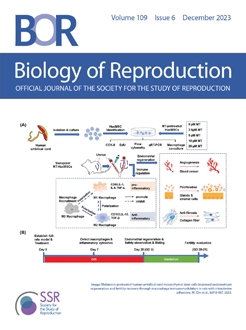During implantation, trophoblast cell invasion and differentiation is predominantly important to achieving proper placental formation and embryonic development. The chemokine, C-X-C motif chemokine ligand 12 (CXCL12) working through its receptor C-X-C motif chemokine receptor 4 (CXCR4) is implicated in implantation and placentation but precise roles of this axis are unclear. Suppressing CXCL12/CXCR4 signaling at the fetal-maternal interface in sheep reduces trophoblast invasion, disrupts uterine remodeling, and diminishes placental vascularization. We hypothesize these negative impacts during implantation will manifest as compromised fetal and placental growth at midgestation. To test, on day 12 postbreeding, osmotic pumps were surgically installed in 30 ewes and delivered intrauterine CXCR4 inhibitor or saline for 7 or 14 days. On day 90, fetal/maternal tissues were collected, measured, weighed, and maternal (caruncle) and fetal (cotyledon) placenta components separated and analyzed. The objectives were to determine if (i) suppressing CXCL12/CXCR4 during implantation results in reduced fetal and placental growth and development and (ii) if varying the amount of time CXCL12/CXCR4 is suppressed impacts fetal/placental development. Fetal weights were similar; however greater placental weight and placentome numbers occurred when CXCL12/CXCR4 was suppressed for 14 days. In caruncles, greater abundance of fibroblast growth factor 2, vascular endothelial growth factor A, vascular endothelial growth factor A receptor 1 (FLT-1), and placental growth factor were observed after suppressing CXCL12/CXCR4. Similar results occurred in cotyledons except less vascular endothelial growth factor in 7 day group and less fibroblast growth factor in 14 day group. Our data underscore the importance of CXCL12/CXCR4 signaling during placentation and provide strong evidence that altering CXCL12-mediated signaling induces enduring placental effects manifesting later in gestation.
Summary Sentence
Disrupting fetal-maternal CXCR4 signaling during implantation in sheep results in placental insufficiency at midgestation with dams having greater number of placentomes, heavier placentas and altered expression of angiogenic and growth factors.
Graphical Abstract
Antagonizing CXCL12/CXCR4 at the fetal-maternal interface during implantation for 7 or 14 days impacts placental growth and development at day 90 with longer antagonism resulting in placental insufficiency, heavier placentas and greater placentome numbers compared to control






